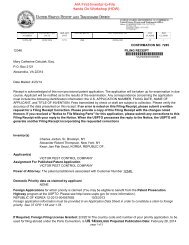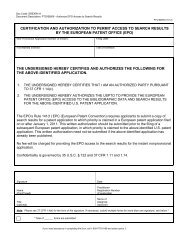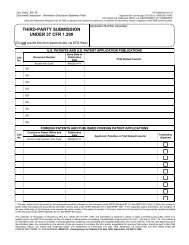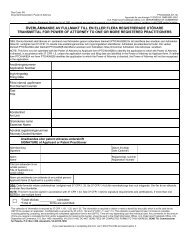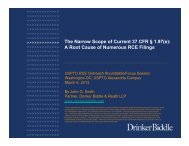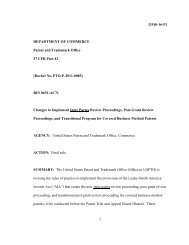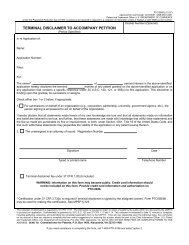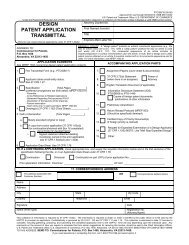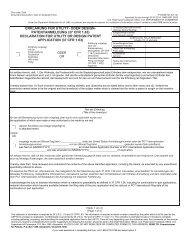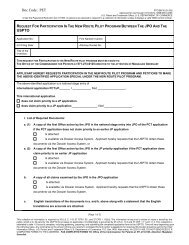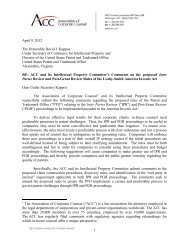First-Inventor-to-File Statutory Framework
First-Inventor-to-File Statutory Framework
First-Inventor-to-File Statutory Framework
Create successful ePaper yourself
Turn your PDF publications into a flip-book with our unique Google optimized e-Paper software.
Prior Art35 U.S.C. 102(a)(Basis for Rejection)102(a)(1)Disclosure with Prior PublicAvailability Date102(b)(1)Exceptions35 U.S.C. 102(b)(Not Basis for Rejection)(A)Grace Period Disclosure by <strong>Inven<strong>to</strong>r</strong>or Obtained from <strong>Inven<strong>to</strong>r</strong>(B)Grace Period Intervening Disclosureby Third Party102(a)(2)U.S. Patent, PublishedU.S. Patent Application,and Published PCTApplication withPrior Filing Date<strong>First</strong>-<strong>Inven<strong>to</strong>r</strong>-<strong>to</strong>-<strong>File</strong>Statu<strong>to</strong>ry <strong>Framework</strong>102(b)(2)(A)Disclosure Obtained from <strong>Inven<strong>to</strong>r</strong>(B)Intervening Disclosure by Third Party(C)Commonly Owned Disclosure
AIA 35 U.S.C. 102: Conditions for patentability; novelty(a) NOVELTY; PRIOR ART.—A person shall be entitled <strong>to</strong> a patent unless—(1) the claimed invention was patented, described in a printed publication, or in public use, on sale, or otherwise available <strong>to</strong> the public before the effectivefiling date of the claimed invention; or(2) the claimed invention was described in a patent issued under section 151, or in an application for patent published or deemed published under section122(b), in which the patent or application, as the case may be, names another inven<strong>to</strong>r and was effectively filed before the effective filing date of theclaimed invention.(b) EXCEPTIONS.—(1) DISCLOSURES MADE 1 YEAR OR LESS BEFORE THE EFFECTIVE FILING DATE OF THE CLAIMED INVENTION.—A disclosure made 1 year or less before the effectivefiling date of a claimed invention shall not be prior art <strong>to</strong> the claimed invention under subsection (a)(1) if—(A) the disclosure was made by the inven<strong>to</strong>r or joint inven<strong>to</strong>r or by another who obtained the subject matter disclosed directly or indirectly from theinven<strong>to</strong>r or a joint inven<strong>to</strong>r; or(B) the subject matter disclosed had, before such disclosure, been publicly disclosed by the inven<strong>to</strong>r or a joint inven<strong>to</strong>r or another who obtained thesubject matter disclosed directly or indirectly from the inven<strong>to</strong>r or a joint inven<strong>to</strong>r.(2) DISCLOSURES APPEARING IN APPLICATIONS AND PATENTS.—A disclosure shall not be prior art <strong>to</strong> a claimed invention under subsection (a)(2) if—(A) the subject matter disclosed was obtained directly or indirectly from the inven<strong>to</strong>r or a joint inven<strong>to</strong>r;(B) the subject matter disclosed had, before such subject matter was effectively filed under subsection (a)(2), been publicly disclosed by the inven<strong>to</strong>r or ajoint inven<strong>to</strong>r or another who obtained the subject matter disclosed directly or indirectly from the inven<strong>to</strong>r or a joint inven<strong>to</strong>r; or(C) the subject matter disclosed and the claimed invention, not later than the effective filing date of the claimed invention, were owned by the sameperson or subject <strong>to</strong> an obligation of assignment <strong>to</strong> the same person.(c) COMMON OWNERSHIP UNDER JOINT RESEARCH AGREEMENTS.—Subject matter disclosed and a claimed invention shall be deemed <strong>to</strong> have been owned bythe same person or subject <strong>to</strong> an obligation of assignment <strong>to</strong> the same person in applying the provisions of subsection (b)(2)(C) if—(1) the subject matter disclosed was developed and the claimed invention was made by, or on behalf of, 1 or more parties <strong>to</strong> a joint research agreementthat was in effect on or before the effective filing date of the claimed invention;(2) the claimed invention was made as a result of activities undertaken within the scope of the joint research agreement; and(3) the application for patent for the claimed invention discloses or is amended <strong>to</strong> disclose the names of the parties <strong>to</strong> the joint research agreement.(d) PATENTS AND PUBLISHED APPLICATIONS EFFECTIVE AS PRIOR ART.—For purposes of determining whether a patent or application for patent is prior art <strong>to</strong> aclaimed invention under subsection (a)(2), such patent or application shall be considered <strong>to</strong> have been effectively filed, with respect <strong>to</strong> any subject matterdescribed in the patent or application—(1) if paragraph (2) does not apply, as of the actual filing date of the patent or the application for patent; or(2) if the patent or application for patent is entitled <strong>to</strong> claim a right of priority under section 119, 365(a), or 365(b), or <strong>to</strong> claim the benefit of an earlier filingdate under section 120, 121, or 365(c), based upon 1 or more prior filed applications for patent, as of the filing date of the earliest such application thatdescribes the subject matter.


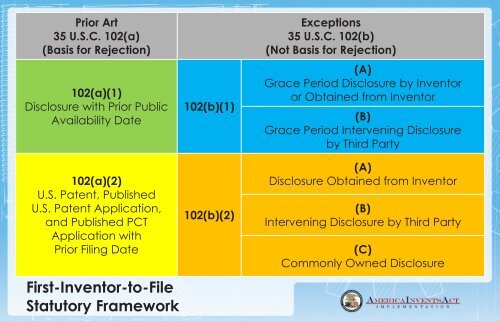
![Printable version [PDF] - United States Patent and Trademark Office](https://img.yumpu.com/51835259/1/184x260/printable-version-pdf-united-states-patent-and-trademark-office.jpg?quality=85)
